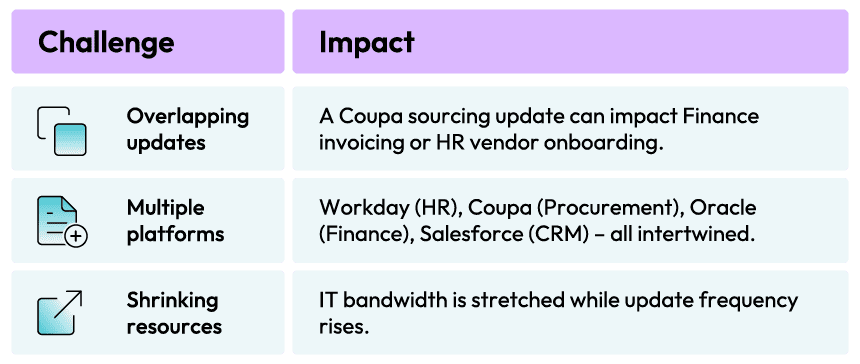Why ERP Change Is More Challenging
Today’s ERP environments are more interconnected and dynamic than ever, with overlapping updates and increasingly complex integrations. Smaller teams must juggle rising demands with limited resources, while the expectation of zero-disruption go-lives never disappears.
Managing change across the ERP stack has always been one of the most daunting aspects of application management—and today, it’s only getting harder. Enterprises face relentless quarterly Coupa releases, Workday updates, and Oracle patches that constantly test the stability of HR, Finance, and Procurement. A unified, AI-powered approach—pioneered by Opkey—turns this challenge into a strategic advantage by integrating automation, cross-ERP testing, and intelligent change governance.
A missed dependency—like a Coupa sourcing change affecting Finance invoicing or HR vendor onboarding—can ripple into costly errors and compliance risks. In fact, 62% of IT leaders report update delays due to integration issues, and missed dependencies cause up to 40% of post-update failures
The Challenge
Every ERP update—whether it’s a Workday release, a Coupa upgrade, or an Oracle patch—ripples directly into the user experience. Employees log in to find changed screens, new workflows, or retired features. Without clear communication or training, confusion sets in. Productivity dips, adoption suffers, and helpdesk tickets spike.
Traditionally, organizations have handled these changes in silos: IT tracks system changes, business teams scramble to retrain users, and auditors piece together compliance evidence after the fact. This fragmented approach often means each function works in isolation, with little visibility into how updates affect one another.
The result? Gaps and inefficiencies:
- Missed dependencies trigger costly post-update incidents.
- Duplicated testing inflates timelines and budgets with redundant efforts.
- Delayed audits drag compliance reviews out 40% longer due to scattered visibility.
Without a unified strategy, small updates can snowball into major disruptions that hurt user confidence, delay business outcomes, and increase compliance risks.
E-book: Demystifying Oracle HCM Cloud Migrations: Best Practices for a Smooth Transition
Why Change Feels Harder Than Ever
ERP ecosystems are more interconnected than ever before.

62% of IT leaders (Opkey Surve) reported their last ERP update was delayed due to integration-related issues.
The Ripple Effect: Interdependencies Across HR, Finance & Procurement
Changes rarely stay contained. A single missed dependency can trigger a chain reaction:

These ripple effects often lead to costly errors, delayed payments, and compliance violations.
The 5 Pillars of Unified Change Management
Effective ERP change management can be broken into five key pillars that guide organizations through updates with clarity, speed, and control. Each pillar—from impact analysis to AI-driven automation—ensures changes are not only managed but transformed into opportunities for greater efficiency and resilience.
- Centralized Impact Analysis: The first step in managing ERP change is understanding its ripple effect. Centralized impact analysis helps organizations see exactly which processes, tests, and compliance requirements will be affected by each update—removing guesswork and enabling smarter prioritization.
- Cross-Functional Collaboration: ERP change impacts multiple business functions. Without cross-functional visibility, teams often work at cross-purposes. A shared workspace for HR, Finance, Procurement, and IT ensures that priorities are aligned and delays are minimized.
- Continuous Testing & Validation: Change is constant, so testing must be continuous. Automated regression and UAT ensure that every update is validated before it reaches production, reducing the risk of business disruption and accelerating release cycles.
- Governance & Compliance: Updates don’t just affect functionality—they impact compliance, too. Automated documentation and audit trails make it easy to prove controls are in place, reducing the time and stress of regulatory reviews.
- Technology Enablement: Finally, modern change management depends on technology enablers like agentic AI, self-healing scripts, and process mining. These tools don’t just accelerate execution; they transform change into an opportunity for efficiency and innovation.

Opkey’s Agentic AI Advantage
- Opkey moves beyond no-code automation with agentic AI—an intelligent layer that addresses both known and unforeseen changes:
- Change Detection: Preemptively identifies ERP updates before they cause breakages.
- Self-Healing Scripts: Auto-update themselves, slashing maintenance by up to 80%.
- Process Mining: Proactively uncovers integration gaps and risks for targeted fixes.
- Cross-ERP Validation: 30,000+ pre-built test cases, including over 2,500 for Coupa, power seamless integration validation.
Next Steps for ERP Leaders
How to Implement a Unified Change Management Framework
- Assess your current gaps: Identify bottlenecks in your change management lifecycle.
- Adopt AI-driven impact analysis: Eliminate manual guesswork.
- Implement continuous testing: Opkey enables automated regression, UAT, and end-to-end testing in days.
- Measure what matters:
Opkey customers report:- 80% less manual testing effort
- 3× faster ERP update cycles
- 70% fewer support tickets
The Bottom Line: From Disruption to Advantage
With Opkey, you can make every ERP change faster, safer, and smarter—start your unified change journey today.
- Automate patch testing & release validation
- Ensure compliance without delays
- Realize ROI from every ERP update
The enterprises that thrive aren’t the ones that fear change—
they’re the ones that automate it, govern it, and turn it into an advantage.
With Opkey, you can make every ERP change faster, safer, and smarter—start your unified change journey today.
Frequently Asked Questions
Change management is the process of planning, implementing, and monitoring organizational changes to ensure smooth transitions.
It helps businesses minimize disruption, improve adoption, and achieve desired outcomes during transitions.
Assess impact, plan strategy, communicate effectively, train users, and monitor progress.
It is the structured approach to managing updates, workflows, and process changes within Coupa’s procurement platform.
Coupa provides configurable workflows, role-based permissions, and automated updates to streamline transitions.
Faster adoption, improved compliance, and reduced risks during procurement and finance process changes.
The key challenges in implementing change management include resistance to change, poor communication, lack of training, and inadequate planning. Without the right change management tools and change management software, organizations struggle to align their company culture, drive employee engagement, and ensure smooth change adoption throughout the change management process.
Change management tools and management software improves efficiency by automating impact analysis, streamlining communication with key stakeholders, and reducing manual tasks during the change process. The right change management tools also help track progress, manage organizational change, perform risk assessment, and ensure smooth change adoption across the entire organization. By integrating with project management tools, digital adoption platforms, and existing systems, they enable successful change management, improve employee engagement, and help organizations make informed decisions while maintaining momentum for future efforts.
Integration capability, ease of use, automation features, scalability, and compliance support.
AI tools use machine learning and automation to analyze, predict, and manage organizational changes.
AI tools help streamline change management processes by detecting changes, predicting risks, automating workflows, and recommending optimal actions—making it easier to choose the right change management tools and accelerate every stage of the change process.
Change management software integrates with existing business systems through APIs, data connectors, and workflow automation, ensuring seamless synchronization of updates and smooth execution of the change process.
Leverage automated impact analysis, involve cross-functional teams, and use AI-driven testing for every update.
The 5 R’s of change management—Resistance, Rejection, Reconciliation, Realization, and Retention—define how organizations navigate the change management process. In Coupa change management, these stages help companies address employee concerns, align company culture, and improve change adoption. By using the best change management tools and change management software, businesses can automate workflows, enhance employee engagement, and support models like Lewin’s change model for smoother transitions.
To manage a change order in Coupa, submit a change request, route it through the change management process for approval, and update the PO or contract using Coupa’s change management tools and interface.
The 5 P’s of change management are Purpose, People, Process, Performance, and Persistence, which help organizations implement successful change initiatives and maintain momentum.
Yes, Coupa offers integrated contract lifecycle management, enabling organizations to streamline procurement, manage change, and ensure compliance throughout the change management process.
Change management is the structured approach of guiding people, systems, and processes through organizational change to achieve desired outcomes efficiently.
Awareness, Desire, Knowledge, Ability, and Reinforcement (ADKAR model).
The 5 R’s of change management are Resistance, Rejection, Reconciliation, Realization, and Retention, representing key stages in managing resistance and ensuring successful adoption during the change process.
A change management tool is software that helps organizations plan, track progress, and implement change initiatives efficiently
The four main change management tools and techniques are impact analysis, communication planning, training programs, and performance tracking to support successful organizational change.
Use AI-powered change management tools for change impact detection, automated testing, and predictive analytics to reduce risks and improve decision-making during the change process.
No, but AI tools will automate repetitive tasks, enhance change adoption, and enable smarter, data-driven decisions for organizational change management.
The four types of AI tools used in change management software are predictive analytics, natural language processing (NLP), process automation, and machine learning-based recommendation engines.




